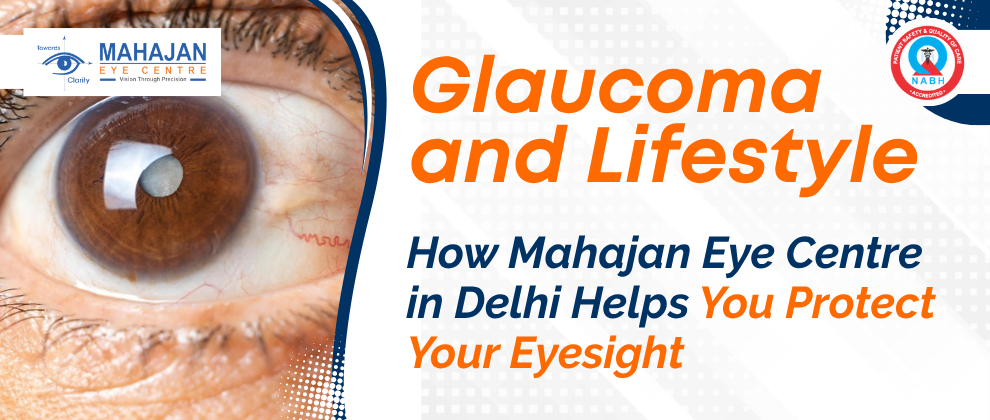
Why lifestyle matters for glaucoma
Glaucoma is often called the “silent thief of sight”. It can steal peripheral vision slowly and painlessly, and once lost, vision usually can’t be recovered. That sounds scary, I know. But here’s the good news: while some risk factors are out of our control (age, family history), lifestyle choices and timely care make a real difference in slowing progression and protecting what remains of your sight.
At Mahajan Eye Centre in Delhi, we combine advanced diagnostics, modern treatments, and practical lifestyle counselling so patients leave with a clear plan not just a prescription. Drawing on our team’s extensive experience treating glaucoma, this post explains how everyday choices influence glaucoma and how our clinic helps patients convert small habit changes into long-term vision gains.
What is glaucoma?
Glaucoma is a group of eye diseases that damage the optic nerve, often (but not always) associated with raised intraocular pressure (IOP). It’s painless early on and commonly goes unnoticed until significant vision is lost. That’s why regular screening is key, especially if you’re over 40, have a family history, or have other risk factors.
Glaucoma causes millions of cases of irreversible vision loss worldwide, and India carries a substantial part of that burden an estimated millions of adults have glaucoma, with many remaining undiagnosed. Early detection and consistent management can slow or prevent progression.
- State-of-the-art technology: Advanced diagnostic and treatment equipment.
- Expertise: Specialists with extensive experience in ophthalmology.
- Comprehensive care: Solutions ranging from basic consultations to complex surgeries.
How lifestyle affects glaucoma
Let’s separate myth from fact. Not every lifestyle tip touted online is proven but several habits do have credible evidence for impacting eye pressure, ocular blood flow, or overall eye health:
- Physical activity & exercise: Moderate aerobic exercise (walking, cycling, swimming) tends to produce a transient reduction in IOP and may be associated with slower visual field loss long-term. (Heads-up: very heavy resistance training/straining can temporarily raise IOP.) In short — move your body, but avoid breath-holding heavy lifts.
- Blood pressure control: Both very high and very low blood pressure can be harmful. Low nocturnal blood pressure in some patients may reduce blood flow to the optic nerve. Good cardiovascular care helps protect the eye.
- Sleep & posture: Sleeping habit/position and frequent head-down postures (e.g., prolonged yoga inversions, certain jobs) can raise eye pressure temporarily. If you have advanced glaucoma, talk to your specialist about posture and activities.
- Smoking, diet & general health: Smoking is associated with poorer eye health. A balanced diet rich in leafy greens, omega-3s, and antioxidants supports ocular health not a cure but part of the big-picture approach.
- Medication adherence & follow-up: This is the single most important “lifestyle” factor for glaucoma patients: taking prescribed eye drops correctly and attending follow-ups drastically lowers risk of progression.
Where studies exist, the evidence tends to support moderation and a comprehensive approach: exercise, stable cardiovascular health, and adherence to treatment combine to help preserve vision.
Practical, clinic-tested lifestyle tips you can start today
Here are bite-sized, realistic actions our patients actually follow simple, low-friction, and effective:
- Daily movement: Aim for 30 minutes of moderate aerobic activity most days (brisk walking, cycling). Even 10–15 minute walks several times a day help.
- Skip breath-holding lifts: If you lift weights, avoid the Valsalva maneuver (holding breath while straining). Use lighter loads with more reps instead.
- Eye-drop routine: Put drops into the lower eyelid pocket, wait 3–5 minutes before other drops, and press the inner corner (nasolacrimal occlusion) for 1 minute to improve absorption and reduce systemic side effects. Use reminders (phone alarms) if you forget.
- Watch your caffeine & hydration: Moderate caffeine is fine for most people, but very high doses may transiently affect IOP again, moderation. Maintain steady hydration.
- Regular eye check schedule: Early-stage glaucoma is silent. If you’re at risk, get baseline tests (IOP check, optical coherence tomography [OCT], and visual fields) and follow-up as recommended.
How Mahajan Eye Centre supports lifestyle-based glaucoma care
We’re not just prescribers, we're partners. At Mahajan Eye Centre, glaucoma care combines technology, tailored treatment, and practical patient support:
- Comprehensive diagnostics: OCT imaging, automated perimeter (visual fields), tonometry, and gonioscopy to create a precise baseline and track tiny changes over time. Early detection is where lifestyle + treatment is most powerful.
- Individualized treatment plans: From drops and laser therapy (SLT) to surgical options including minimally invasive glaucoma surgery (MIGS) when indicated we choose treatments that fit each patient’s life and risk profile.
- Patient education & adherence support: We teach correct drop technique, provide written schedules, set reminder systems, and run counseling sessions so patients understand why sticking to therapy matters. (No one’s perfect, we coach, not scold.)
- Lifestyle counseling integrated with care: Our team discusses exercise, diet, blood pressure control, sleep, and workplace posture as part of the consultation practical tips that fit your routine.
- Multidisciplinary links: If needed, we coordinate with cardiologists, neurologists, or sleep specialists because glaucoma doesn’t live in isolation from the rest of your health.
You can see details of our glaucoma services and the specific technologies we use on our clinic page.
Real-world results — what patients can expect
Glaucoma care is rarely a one-off fix. Expect a partnership:
- Early-stage: With consistent drops, lifestyle adjustments, and monitoring, many patients show little or no progression for years.
- Moderate-stage: Laser therapies like SLT often lower pressure and reduce drop burden; lifestyle measures complement these gains.
- Advanced-stage: Surgical options aim to preserve central vision and slow further loss. Lifestyle measures support recovery and long-term outcomes.
Conclusion — Small Changes, Big Impact
Glaucoma may be stealthy, but it’s not unbeatable. The combination of early detection, evidence-based medical/laser/surgical care, and everyday lifestyle habits gives you the best chance to protect your sight. At Mahajan Eye Centre in Delhi we bring technology, experience, and practical coaching together because preventing vision loss is a team sport.


